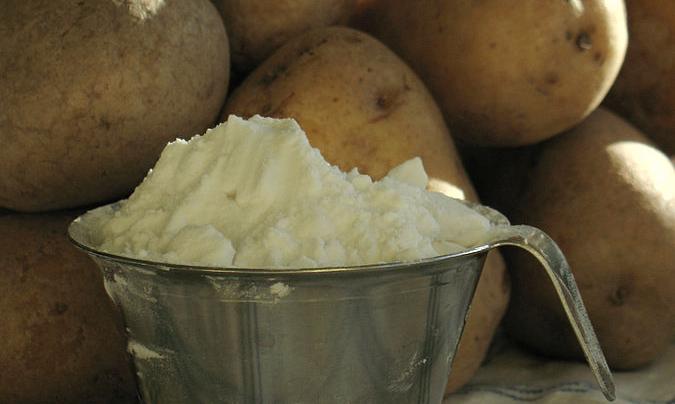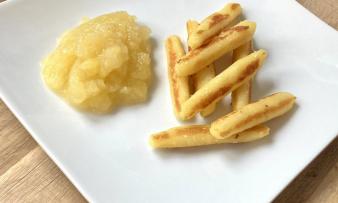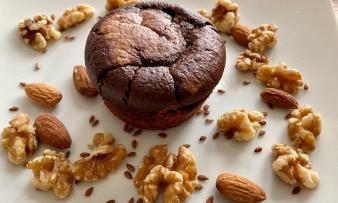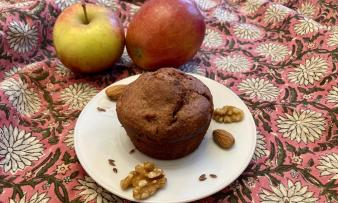Table of contents
Potato flour is a powder made from boiled and dried potatoes. Preferably in organic quality, it is an excellent thickener for soups and sauces, for example. The powder is never raw.
Use in the kitchen
What is potato flour? To make potato flour, you peel whole potatoes, boil them, dry them and grind them into a fine powder. Potato flour is white in color and has a distinct potato taste and smell. It is mainly used in the kitchen to thicken sauces and soups or as a baking ingredient for potato bread, cookies, cakes and desserts. The flour is naturally gluten-free and is also suitable for a vegan diet. Is potato flour cornstarch? The term cornstarch refers solely to starch that is obtained from corn, wheat or potatoes. For potato flour, however, whole potatoes and all their ingredients are used. What is the difference between potato flour and potato starch? While potato starch only consists of starch, potato flour contains fiber and protein in addition to starch. What is potato starch and is potato starch corn starch? Potato starch is starch obtained from potatoes and, like corn starch, is a type of corn starch. In the kitchen, it is used as a binding agent for light sauces, soups, desserts and creams. It is also a component of many ready-made products such as pasta, bread, cakes, biscuits, sweets, canned vegetables or ready-made sauce mixes.
On the other hand, the use of potato flour is particularly popular for making your own potato dumplings, which taste particularly delicious with a vegan mushroom cream sauce (see recipe). Potato flour can also be used to make potato patties, which can be used in cold dishes to make a lamb's lettuce salad with fresh pears, walnuts and grapes, or for homemade gnocchi or potato dumplings, which can be used in a wide variety of dishes.
Below you will find two potato flour recipes.
Vegan recipe for potato dumplings with potato flour
Ingredients (for 4 people): 800 g potatoes, 120 g potato flour (organic), nutmeg (to taste), 200 g mushrooms (e.g. button mushrooms, oyster mushrooms), 1 onion, 1 clove of garlic, 1 tbsp rapeseed oil (refined), 100 ml vegetable stock, 100 ml vegan cream (e.g. oat cream), salt andpepper (to taste).
Preparation: Peel and boil the potatoes. Then drain and allow to evaporate. Press the potatoes through a potato press while they are still warm. Mix the potato flour, salt and nutmeg into the potato mixture. Form the dough into dumplings. Bring the dumplings to the boil in a large pot of salted water and leave to simmer for about 20 minutes. Meanwhile, clean the mushrooms and cut into slices. Peel and finely chop the onion and garlic. Heat the rapeseed oil in a pan and sauté the onion and garlic until translucent. Add the mushrooms and fry for about 5 minutes. Add the vegetable stock and vegan cream and bring to the boil. Season the sauce with salt and pepper. Then serve the vegan potato dumplings with the mushroom sauce.
Vegan recipe for gravy with potato flour
Ingredients (for 4 servings): 1 red onion, 1 clove of garlic, 2 carrots, 3 mushrooms, 2 tbsp potato flour (organic), 2 tbsp tomato paste, 50 ml vegan red wine, 750 ml vegetable stock, 1 tsp mustard, 1 tbsp soy sauce, 1 tbsp agave syrup, 1 tbsp rapeseed oil (refined), salt andpepper (to taste).
Preparation: Peel the onion, garlic and carrots, clean the mushrooms and cut everything into large pieces. Heat the rapeseed oil in a pan over medium heat and fry the vegetables in it for about 8-10 minutes until lightly roasted. Season with salt and pepper. Add the potato flour and tomato paste, mix and fry for another 1-2 minutes. Then deglaze with vegan red wine and pour in the vegetable stock. Stir in the mustard, soy sauce and agave syrup. Let everything simmer together for about 5-10 minutes. Pour the vegan gravy through a fine sieve into a second pot, using the sieve to filter out the vegetables. Put the second pot back on the stove and let the gravy simmer until it has the desired consistency. Season with salt, pepper and/or mustard as desired. You can puree the leftover vegetables and make another sauce with a little soy milk.
Vegan recipes with potato flour can be found under the note: " Recipes that have the most of this ingredient ".
| Not only vegans or vegetarians should read this: Vegans often eat unhealthily. Avoidable nutritional errors. |
Purchasing - Storage
Potato flour is available all year round, primarily online, as well as in health food stores and drugstores. According to our research, only Rewe has potato flour on offer. Coop, Spar, Edeka and Billa offer potato starch (some of which is organic). At Migros, Denner, Volg, Aldi, Lidl, Hofer and organic supermarkets such as Denn's Biomarkt and Alnatura you will find a type of corn starch, although this is usually made from corn. Where can you find corn starch in the supermarket? Corn starch is usually listed with the baking ingredients.
The availability of potato flour varies depending on the size of the store, catchment area, etc. Our recorded food prices for the DA-CH countries can be found above under the ingredient image - and by clicking you can see their development at various suppliers.
Storage tips
Store potato flour in a dry and dark place, preferably in an airtight container.
Ingredients - Nutritional values - Calories
100 g of potato flour provides 357 kcal of energy. This includes 0.34 g fat, 83 g carbohydrates (including 3.5 g sugar) and 6.9 g protein. 1
100 g of the flour contains 0.77 mg of vitamin B6 (55% of the daily requirement). Raw wholegrain rice (0.74 mg/100g) and corn kernels (0.62 mg/100g) contain similarly high amounts. Yeast flakes contain particularly high levels of the vitamin (2.9 mg/100g). 1
The potassium content is 1001 mg/100g. This covers 50% of the daily requirement. Lupine flour (1064 mg/100g) and wheat bran (1182 mg/100g) have similar values. Good sources of potassium are pulses and nuts, such as almonds (733 mg/100g) orchickpeas (718 mg/100g). 1
Niacin (ex vitamin B 3 ) is included at 3.5 mg/100g and covers 22% of the daily requirement. Coconut flour (3.4 mg/100g) and spelt flour (3.6 mg/100g) contain a similar amount of the vitamin. Yeast flakes contain a particularly high amount of niacin (23 mg/100g). 1
Potatoes are a good source of phenolic compounds. These are found in both the skin and the flesh, with the skin containing the largest amounts. Phenolic acids and flavonoids (flavonols, flavanols) as well as anthocyanins are the most abundant. 2 Phenolic compounds are also found in potato flour. However, these can be greatly reduced by processing methods. 14
The complete ingredients of potato flour, the coverage of the daily requirement and comparison values with other ingredients can be found in our nutrient tables. In the article Nutrients explained you will get a detailed insight into the topic.
Health Effects
Potatoes have shown promising health benefits in cell culture, animal studies , and human clinical trials, including antioxidant, hypocholesterolemic, anti-inflammatory, anti-obesity, anti-cancer, and antidiabetic effects.3 They are composed of about 75% water, 21% starch, and 4% other substances.4 Researchers believe that compounds found in potatoes, such as phenols, fiber, starch, and proteins, as well as glycoalkaloids, lectins, and protease inhibitors, contribute to potato health benefits. However, epidemiological studies examining the role of potatoes in human health are inconclusive. Some studies show a protective effect of potato consumption on weight control and diabetes, while others show no effect, and a few suggest a negative effect. The compounds found in potatoes have been attributed numerous biological effects. Because these compounds could be beneficial or detrimental depending on specific circumstances, long-term studies are needed to examine the association between potato consumption and diabetes, obesity, cardiovascular disease and cancer, also taking fat intake into account. 3
Starch is the main energy source in both potato tubers and potato flour and consists of two components: the polysaccharides (complex sugars) amylose and amylopectin. 5 The most interesting starch for human health is the so-called resistant starch. It is formed when, for example, boiled potatoes or products made from them, such as potato flour, cool down. 6 Resistant starch is considered to be the part of the starch molecule that has the unique property of being resistant to enzymatic digestion and reaches the large intestine either unchanged or slightly modified. It is therefore classified as dietary fiber. Resistant starch has gained importance due to its positive effects on human health through prebiotic effects, laxatives, hypocholesterolemic and hypoglycemic effects and the reduction in the risk of ulcerative colitis (chronic inflammation of the colon) and colon cancer, as well as its applications for improving the functional properties of foods. 7
Is potato flour healthy? In a rat model, researchers found that potato flour can increase the concentration of short-chain fatty acids in the gut and promote the growth of certain lactic acid bacteria. 8 There is now a wealth of evidence that short-chain fatty acids play an important role in maintaining health and preventing disease. Short-chain fatty acids are a subset of fatty acids produced by gut microbes during the fermentation of partially and non-digestible polysaccharides. They have anti-inflammatory, anti-tumor and antimicrobial effects, among others, underscoring their role as an important player in maintaining gut health and immune homeostasis. 9
Dangers - Intolerances - Side Effects
We are not aware of any dangers, intolerances or side effects resulting from the internationally common consumption of potato flour.
However, potato flour is a highly processed product that has a high energy value and comparatively little fiber and micronutrients. Prefer products that are as little processed as possible, in this case boiled potatoes.
Ecological footprint - animal welfare
The ecological footprint of a food depends on various factors. The type of agricultural production (conventional vs. organic), seasonal, regional or domestic production or import by truck, ship or plane, different types of packaging and whether the goods are fresh or frozen all play a decisive role. 10
Fresh potatoes have a CO 2 footprint of 0.39 kg CO 2 eq/kg (2021: 0.36 kg CO 2 eq/kg), which can be classified as comparatively low. 10,11 Potato flour is calculated with an ecological footprint of 1.6 kg CO 2 eq/kg (2021: 1.31 kg CO 2 eq/kg), which is slightly higher than that of raw potatoes due to the additional processing steps. 11
The amount of water required to produce 1 kg of potato flour is 1436 litres. 12
Worldwide occurrence - cultivation
Information on the worldwide occurrence and cultivation of potatoes can be found directly in the article on the ingredient potatoes, raw (organic?).
Industrial production
The industrial production of potato flour can vary slightly depending on the producer, but essentially follows the following steps. After transport and any intermediate storage of the fresh potatoes, the first step is washing. Then the potatoes are peeled, cut up, subjected to a process to protect the color, steamed and dried before they are mashed into a powder, sieved, packed airtight and released for distribution. 13 Potato flour is therefore never raw. The starch extraction process is subject to a somewhat more complex process, which you can read about, for example, in the ingredient corn starch (organic corn starch?).
Further information
As an alternative to potato flour, you can use wheat flour, spelt flour, rice flour, almond flour, oat flour, quinoa flour or locust bean gum. However, you cannot assume a 1:1 ratio for every alternative.
Alternative names
Potato flour is called "potato flour" in English.
Bibliography - 13 Sources (Link to the evidence)
| 1. | USDA United States Department of Agriculture. |
| 2. | Akyol H, Riciputi Y et al. Phenolic compounds in the potato and its byproducts: an overview. IJMS. 2016;17(6):835. |
| 3. | Visvanathan R, Jayathilake C et al. Health‐beneficial properties of potato and compounds of interest. J Sci Food Agric. 2016;96(15):4850–4860. |
| 5. | Xu J, Li Y, Kaur L, Singh J, Zeng F. Functional food based on potato. Foods. 2023;12(11):2145. |
| 6. | Chemie de: Ballaststoff. |
| 7. | Tacer-Caba Z, Nilufer-Erdil D. Resistant starch. In: Melton L, Shahidi F, Varelis P, Hrsg. Encyclopedia of Food Chemistry. Elsevier; 2019: 571–575. |
| 8. | Kawakami S, Han KH et al. Potato powders prepared by successive cooking-process depending on resistant starch content affect the intestinal fermentation in rats. Bioscience, Biotechnology, and Biochemistry. 2017;81(2):359–364. |
| 9. | Tan J, McKenzie C et al. Chapter 3: The role of short-chain fatty acids in health and disease. In: Alt FW, Hrsg. Advances in Immunology. Elsevier; 2014: 91–119. |
| 10. | Reinhardt G, Gärtner S, Wagner T. Ökologische Fussabdrücke von Lebensmitteln und Gerichten in Deutschland. IFEU Institut für Energie- und Umweltforschung Heidelberg. 2020:1-22. |
| 11. | Concito. Denmark's green think tank. The big Climate Database. Version 1.1. Potato / Potato flour. 2024. |
| 12. | Mekonnen MM, Hoekstra AY. The green, blue and grey water footprint of crops and derived crop products. Hydrol. Earth Syst. Sci. 2011;15:1577-1600. |
| 13. | Lingling C, Yange T et al. Preparation of potato whole flour and its effects on quality of flour products: a review. Grain & Oil Sci and Technol. 2018;1(3):145–150. |
| 14. | Nascimento RF do, Canteri MHG. Effect of blanching on physicochemical characteristics of potato flour. Hortic Bras. 2018;36(4):461–465. |











Comments